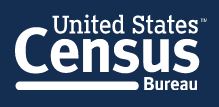The Census
The U.S. Constitution (Article 1, Section 2) requires that every 10 years, the Census Bureau (a nonpartisan government agency) conducts a population and housing count of the United States. People of all ages, races, ethnic groups, citizens, and non-citizens are counted. The census counts the populations in all 50 states, the District of Columbia, and five U.S. territories (Puerto Rico, American Samoa, the Commonwealth of the Northern Mariana Islands, Guam, and the U.S. Virgin Islands). Each home receives an invitation to respond to a short questionnaire – online, by phone, or by mail.
Responding to the census is not only your civic duty; it also affects how your community plans for the future, your representation in government, and determines how more than $675 billion in funds is distributed to states each year to spend on schools, hospitals, housing, employment, roads, public works, and other vital community programs. The census count provides a snapshot of our nation and a rich set of data that includes population trends and growth projections.
The results determine the number of seats each state has in the House of Representatives. They are also used to draw congressional and state legislative districts based on where populations have increased or decreased. State legislatures or independent bipartisan commissions are responsible for redrawing congressional districts. The U.S. Census Bureau provides states with population counts for this purpose.
Census data also shows where communities need new schools, clinics, roads, and more services for families, older adults, and children and informs how hundreds of billions of dollars in federal funding are allocated to communities across the country for hospitals, fire departments, school lunch programs, and over 100 other critical programs and services. The count affects funding for many programs at AEOA, including Head Start, Meals on Wheels, Energy Assistance, and more.
The results of the census helps determine how hundreds of billions of dollars in federal funding flow into communities every year for the next decade. That funding shapes many different aspects of every community, no matter the size, no matter the location. The count provides critical data that lawmakers, business owners, teachers, and many others use to provide daily services, products, and support for you and your community.
- Local businesses: Business owners rely on valuable census data to make decisions, such as where to open new stores, restaurants, factories, or offices, where to expand operations, where to recruit employees, and which products and services to offer.
- Your morning commute: Census results influence highway planning and construction, as well as grants for buses, subways, and other public transit systems.
- Local schools: Census results help determine how money is allocated for the Head Start program and for grants that support teachers and special education.
- The list goes on, including programs to support rural areas, to restore wildlife, to prevent child abuse, to prepare for wildfires, and to provide housing assistance for older adults.
This once in a decade event is critical for Community Action Agencies like AEOA and the families and communities we serve across the Arrowhead Region. Every person counted is equal to $2,000 in funding to our communities a year, for ten years. When undercounted, communities lose their fair share of resources and representation in government.
Populations served by Community Action Agencies like AEOA are historically hard-to-count populations and AEOA plays a key role in working to make sure these hard-to-count people and communities are counted in the Census and offer concrete tools and training to help our front-line staff maximize Census participation. AEOA is committed to promoting a fair and accurate census count so our communities will receive enough federal dollars to fund many of our vital community programs including Head Start, fuel assistance, Weatherization and more.
The questionnaire only takes about 10 minutes to complete. For the first time, households will have the option of responding online. Households are asked about everyone living or staying in the home (even temporarily) on April 1, 20XX (Census Day), including the living situation, age, sex, race, ethnic group, and relationship of each person.
The last census count was in 2020 and the next census count will be in 2030. Beginning mid-March, people receive a notice in the mail to participate in the census. It will be a short questionnaire, and households can respond online, by phone, or by mail by the deadline.
Yes. Strict federal law protects your census responses. It is against the law for any Census Bureau employee to disclose or publish any Census information that identifies an individual. The penalty for wrongful disclosure is a fine of up to $250,000 or imprisonment for up to 5 years, or both. No law enforcement agency (not the DHS, ICE, FBI, or CIA) can access or use your personal information at any time. Data collected can only be used for statistical purposes.
The Census Bureau will never ask for your Social Security number, bank or credit card account numbers, money or donations, or anything on behalf of a political party. If someone claiming to be from the Census Bureau contacts you via email or phone and asks for one of these things, it’s a scam, and you should not cooperate.
Phishing is a criminal act in which someone tries to get your information by pretending to be an entity that you trust. Phishing emails often direct you to a website that looks real but is fake—and may be infected with malware. It is important to know that the Census Bureau will not send unsolicited emails to request your participation in the census.
In May, Census Bureau employees begin following up in person with households that haven’t responded. For each person who chooses not to respond, our communities could lose an average of $20,000 over the next ten years. Respond to the census and encourage your family, friends, and neighbors to respond so everyone in our communities will be accurately counted so our communities get our fair share of federal and state funding. The best way to avoid a follow-up visit from a census taker is to fill out the census questionnaire online, by phone, or by mail as soon as you receive your invitation to participate.
You might see census takers in your neighborhood for a few different reasons:
- They are verifying addresses in preparation for the census
- They are collecting responses tot he census or another survey
- They are dropping off census materials
- They are conducting quality checks related to the census
If someone visits your home to collect a response for the census, you can do the following to verify their identity:
- First, check to make sure they have a valid ID badge, with their photograph, a U.S Department of Commerce watermark, and an expiration date.
- If you still have questios about their identity or suspect fraud, call 800-923-8282 to speak with a local census bureau representative. If it's determined that the visitor who came to your doordoes not work for the Census Bureau, contact your local police department.
Once every ten years during the census, the U.S. Census Bureau hires temporary positions in our area. By working for the Census Bureau, you can help them reach their goal for the census to ensure everyone is counted. Census counts have a huge impact on our community and working for the census looks great on a resume!
AEOA staff can assist you with the census and answer questions, however, they cannot complete your questionnaire for you. For assistance, stop by any AEOA office or call 800-662-5711. Let’s get our fair share of federal and state funding. Responding to the census to help our communities get our fair share of funding and representation. For more information, visit www.census.gov/




